Study schedules online. The history of the startup Schoodle
This post will cover my experience and the experience of our team in the production and promotion of the service Schoodle.ru .
The subject of study schedules is completely beaten. On the automation of their compilation written tens of thousands of theses peacefully resting in the archives of hundreds of universities. Creating a universal tool for scheduling, if technically possible, then making this an economically successful project is, in my opinion, practically unrealistic (I agree with the author of the post Program for Scheduling Lessons at a University ). But I decided to solve the problem of conveniently placing a schedule online with some additional buns (with a focus on end-users of schoolchildren and students).
I am 33 years old and I live and work in a small town in Ukraine. For ten years of my life I worked as the head of a software company with a specialization in the production of desktop software in construction. After my dismissal in June 2011, I firmly decided to go to entrepreneurs and create my own Internet project. In order to consolidate my desire and expertise in the field of webmastering and SEO, I worked a little in the SEO studio of my friends.
I started by creating in my Evernote a note “100 ideas of my own business” and filled it in a couple of weeks. Among other ideas, Schoodle (from the school schedule) was distinguished by the widest potential audience, niche vacancy and wow-effect potential.
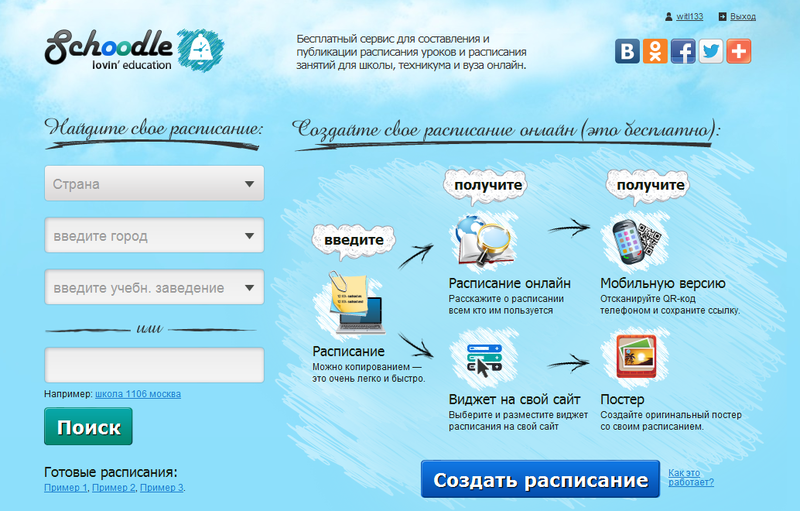
')
Actually the idea of the project: any user can enter their training schedule and publish its page, get a mobile version, a widget for publication on another site and make your print poster with the schedule. Like Youtube is a movie publisher, Picassa is a photo gallery, Schoodle is a schedule publisher.
Direct projects can be considered projects kakieuroki.ru (targeting students, there is no mobile version, widget, poster) and stud-net.ru (targeting students, there is a mobile version, there are no widgets and posters). Schoodle's know-how is the ability to create multiple schedules for one study group / class. The service ranks the entered schedules and determines the most accurate one, setting it as “basic”, the rest also remain available. Ranking is based on user votes and a special trust rating - the author’s readiness to publish a link in the social network, publish to his site, specify his full name and e-mail. It turns out that really any user can enter their schedule and get it in the phone, without fear that the next bully will enter the service and scroll it.
In fact, the service solves several problems:

The minuses of the idea can be considered seasonality, low monetization of the traffic of this audience, high risks due to the novelty of this category of services. With a considerable number of benefits, the value of use is not very high (not the fact that it will exceed the laziness of introducing the schedule) - it is obvious that the transition to calendars suggests taking into account the actual schedule and storage of homework (this is actually in perspective).
The service, of course, is free for users. In essence, this is a UGC- platform and, accordingly, monetization methods are assumed to be:
- Placement and sale of advertising (in the framework of decency, of course);
- Sale of premium versions of mobile applications (when we make them);
- As a mass audience is received, it has its own advertising and lead selling platform (you can target by geography, by educational institutions, by classes / courses, or by the presence of certain classes in the schedule). For example: a tutor will be able to create his own page with a lead form and display ads on it for a particular educational institution or class and at the same time pay for completed applications.
This list consists of the highest priority methods.
In addition, we initially plan to go to foreign markets (and therefore the name is English), although in its current form the value of the project for countries with elective education (where each has its own schedule and no training groups) is very small. By the way, who knows which countries other than the CIS do not have this system?
I am sure that the greatest interest of the Habrasoobshchestvo will be specifically to the schedule designer, so I’ll stop on the work of this module separately.
Schedule Designer works for schools / universities / secondary schools / other uch. institutions. And provides for the accounting of study periods, call schedules (including difficult ones for different days of the week), division into shifts, accounting of groups and / or classes, division into even / odd weeks, division into subgroups, preservation of reference books of subjects, teachers, audiences and types of occupations. We tried to do all this in the mode of the minimum number of clicks with the maximum possible understanding by the end user.
Stage I. The choice of school and period.
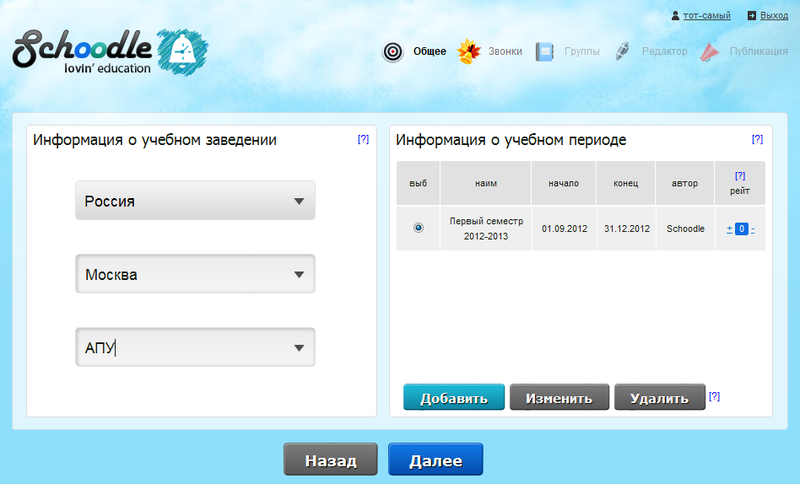
All created periods are saved. You can only change those that he created. If periods for this uch. the establishment was not created, the estimated current period is automatically made and selected.
Stage II. Select or enter a call schedule.

A suitable call schedule is selected or a new one is created. Guides conduct educational program, they are also available on all tabs and in the mode of prompts.
Stage III. Select or enter study group or class
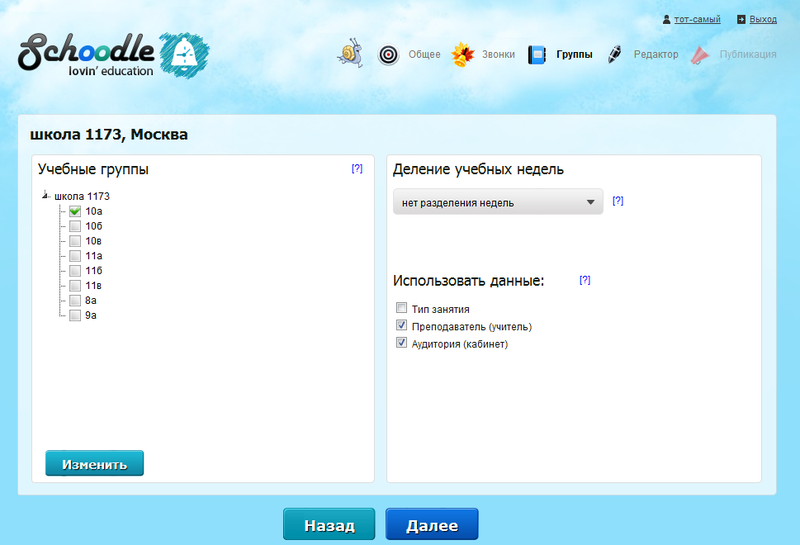
Add study groups (if they have not been previously entered by other users for this school). You can select several learning groups at once - then at the next stage you can enter schedules for all selected at once.
Stage IV. Schedule editor
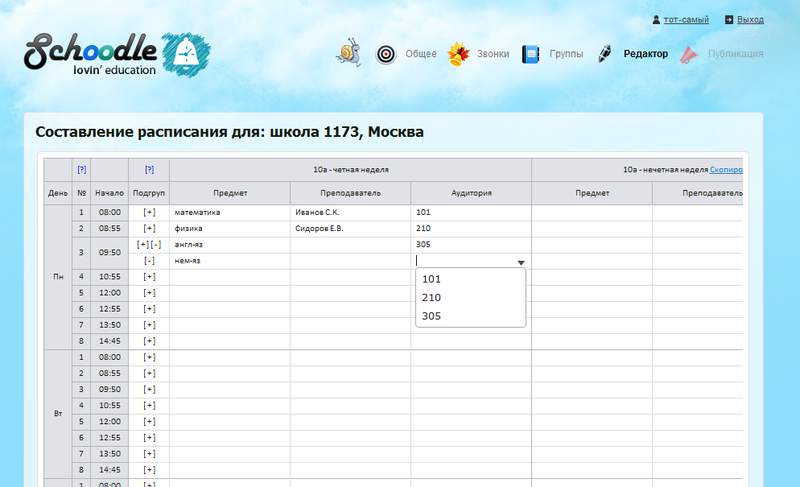
The editor a la MS Excel is formed according to the selected schedule of calls and groups. You can create divisions into subgroups. All entered values in the cells are remembered - just enter once and then simply select from the list. All entered values will then be offered for replenishment in the general directory of accounts. institutions and the next authors of the school or university, they will be available. Entering an odd week is carried out in a separate column: there you can just copy everything from an even one, and change what is different.
Stage V. Schedule publication

Check before publication, plus a few options.
The page of the created schedule looks like this:
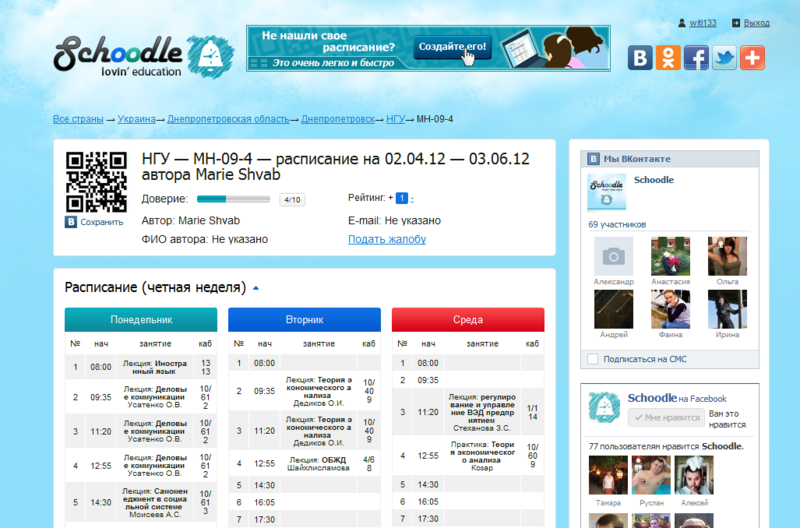
And the mobile version is:
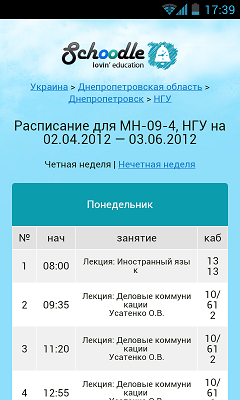
In addition to manually entering schedules, we planned to make an external file analyzer with schedules from the very beginning - so that you can load your MS Word / Excel file. But after reviewing a large number of files with examples, it became clear that this task would seriously slow us down and not at all the fact that the percentage of successful processing of such files will be higher than 5-10%. It was decided to make a standard MS Excel template so that users could conveniently copy the data of their file into this one, and we are already more likely to import it, but, ultimately, we just made our own editor in MS Excel style and supported it with the ability to insert selected data group:
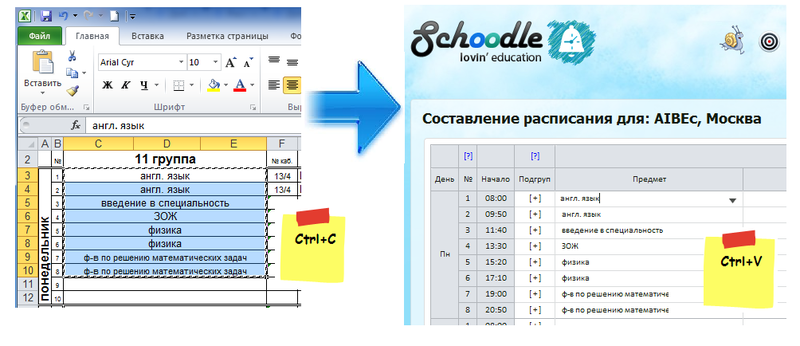
Of course, you can also import from program files for scheduling ( Rector , Nick , etc.) - there is usually quite a convenient format of the XML type. This task is in the roadmap, but so far there are no clear priorities from live users.
In practice, if you compare the use of Schoodle with the universal calendar ( Google Calendar ), you get the following advantages and disadvantages:
September 2011: TZ design and team building started. For the position of CTO, jcrow is selected. Work has begun on the design. Selected tools and technologies to be used:
November 2011: the development of the software skeleton is completed, the additional full-time PHP programmer is taken into the team.
December 2012: another PHP / JS programmer is taken to the fulltime team. Completed work on the design and layout.
March 2012: closed alpha version released. Testing and refinement.
April 10, 2012: official launch of the public beta.
As it always happens, the release dates and the estimated budget were almost exceeded twice. It is clear that at the very end of the school year there was no interest in the service. We managed to conduct a good test and bug fixes (users for this period published 376 schedules).
I can not say that we managed to reach heights in advancement, the summer period is not indicative, and more accurate conclusions can be made only in the fall. From those that have tried:
What methods will we use from September (in addition to those listed):
There are also plans for offline events. This list is not complete and its priorities may change significantly.
From mid-June, the project is on vacation: only I and jcrow are working on the project - we are working on SEO, as well as small features and bug fixes. We rent a small room (the benefit is very inexpensive in our city). We plan to bring other team members back as soon as activity is visible and funding appears.
In all things, today we are in the very center of the valley of death - the opportunity to finance the project on our own is not, but active use has not yet begun. It is clear that I already went with him to investors: in all cases I received the same answer - you need to wait for the fall and see the dynamics and in the event of take-off, look for venture capital investors. Two angel investors showed interest in the project, but it never came to that. In fact, I cannot now talk about some kind of return on investment — it’s perfectly logical that until that moment no one would give money (he would not have given). Since the project is a socially useful tool that increases interest in education, it makes sense to get a grant for it - today our project is considered in two programs for receiving grants.
By the way, one well-known investor told me that the topic of education and the timetable in particular is already a whole cemetery where a large number of initiatives and start-ups were killed. It is obvious that at the sowing stage under such an idea it was unlikely to receive investments precisely because of this statistics ...
And yet, we are almost always confused with the next electronic diary ( LMS-system ) - the similarity between Schoodle and electronic diaries, in fact, there is in terms of the availability of the schedule. The schedule in the electronic diary can be created only by the administration, and it is closed from free access - respectively, it does not have all the submissions (and not their goal), in Schoodle anyone can make a schedule, and it does not require introductions in schools. Yes, and automate electronic diaries, as a rule, only schools. Of course, the functionality of just displaying the schedule for us is only the beginning, but at the moment we do not have plans for retraining into an electronic diary. Well, the development plans for the project are as follows:
A lot of effort has already been put into the project: more than a year of my work, a total of more than 1,900 man-hours of development. We continue to believe in its success, and user reviews tell us that this is a necessary thing.
We will be grateful to your criticism, advice and suggestions for cooperation.
The subject of study schedules is completely beaten. On the automation of their compilation written tens of thousands of theses peacefully resting in the archives of hundreds of universities. Creating a universal tool for scheduling, if technically possible, then making this an economically successful project is, in my opinion, practically unrealistic (I agree with the author of the post Program for Scheduling Lessons at a University ). But I decided to solve the problem of conveniently placing a schedule online with some additional buns (with a focus on end-users of schoolchildren and students).
About myself
I am 33 years old and I live and work in a small town in Ukraine. For ten years of my life I worked as the head of a software company with a specialization in the production of desktop software in construction. After my dismissal in June 2011, I firmly decided to go to entrepreneurs and create my own Internet project. In order to consolidate my desire and expertise in the field of webmastering and SEO, I worked a little in the SEO studio of my friends.
The rudiments of the project
I started by creating in my Evernote a note “100 ideas of my own business” and filled it in a couple of weeks. Among other ideas, Schoodle (from the school schedule) was distinguished by the widest potential audience, niche vacancy and wow-effect potential.

')
Actually the idea of the project: any user can enter their training schedule and publish its page, get a mobile version, a widget for publication on another site and make your print poster with the schedule. Like Youtube is a movie publisher, Picassa is a photo gallery, Schoodle is a schedule publisher.
Direct projects can be considered projects kakieuroki.ru (targeting students, there is no mobile version, widget, poster) and stud-net.ru (targeting students, there is a mobile version, there are no widgets and posters). Schoodle's know-how is the ability to create multiple schedules for one study group / class. The service ranks the entered schedules and determines the most accurate one, setting it as “basic”, the rest also remain available. Ranking is based on user votes and a special trust rating - the author’s readiness to publish a link in the social network, publish to his site, specify his full name and e-mail. It turns out that really any user can enter their schedule and get it in the phone, without fear that the next bully will enter the service and scroll it.
In fact, the service solves several problems:
- Access to the schedule in a convenient way to any users, including using a search engine.
- Schedule at hand, on the phone by scanning the qr-code or searching it in m.schoodle.ru .
- Placing schedules in a convenient way, on the websites of educational institutions using widgets (non-usable DOC / XLS / PDF files with schedules - into the furnace). The school widget looks like this:
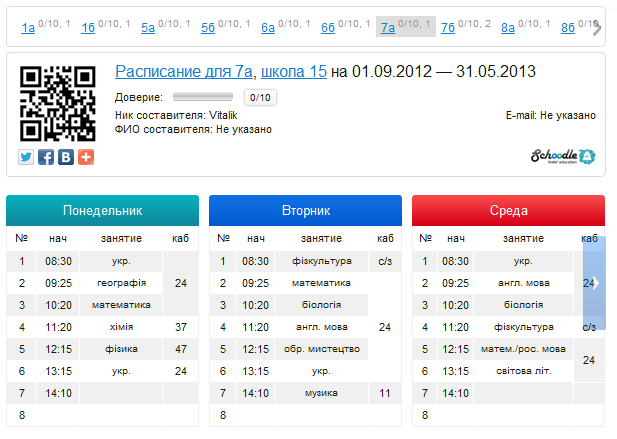
- Quickly create and print a print poster with a schedule.
- Along the way, we received a catalog of educational institutions, where there will be unique data on current timetables for calls, popular teachers and subjects, and others that are aggregated from current schedules. Now in the catalog about 250 thousand. uch. institutions.

The minuses of the idea can be considered seasonality, low monetization of the traffic of this audience, high risks due to the novelty of this category of services. With a considerable number of benefits, the value of use is not very high (not the fact that it will exceed the laziness of introducing the schedule) - it is obvious that the transition to calendars suggests taking into account the actual schedule and storage of homework (this is actually in perspective).
Business model
The service, of course, is free for users. In essence, this is a UGC- platform and, accordingly, monetization methods are assumed to be:
- Placement and sale of advertising (in the framework of decency, of course);
- Sale of premium versions of mobile applications (when we make them);
- As a mass audience is received, it has its own advertising and lead selling platform (you can target by geography, by educational institutions, by classes / courses, or by the presence of certain classes in the schedule). For example: a tutor will be able to create his own page with a lead form and display ads on it for a particular educational institution or class and at the same time pay for completed applications.
This list consists of the highest priority methods.
In addition, we initially plan to go to foreign markets (and therefore the name is English), although in its current form the value of the project for countries with elective education (where each has its own schedule and no training groups) is very small. By the way, who knows which countries other than the CIS do not have this system?
The principle of the schedule designer
I am sure that the greatest interest of the Habrasoobshchestvo will be specifically to the schedule designer, so I’ll stop on the work of this module separately.
Schedule Designer works for schools / universities / secondary schools / other uch. institutions. And provides for the accounting of study periods, call schedules (including difficult ones for different days of the week), division into shifts, accounting of groups and / or classes, division into even / odd weeks, division into subgroups, preservation of reference books of subjects, teachers, audiences and types of occupations. We tried to do all this in the mode of the minimum number of clicks with the maximum possible understanding by the end user.
Stage I. The choice of school and period.

All created periods are saved. You can only change those that he created. If periods for this uch. the establishment was not created, the estimated current period is automatically made and selected.
Stage II. Select or enter a call schedule.

A suitable call schedule is selected or a new one is created. Guides conduct educational program, they are also available on all tabs and in the mode of prompts.
Stage III. Select or enter study group or class

Add study groups (if they have not been previously entered by other users for this school). You can select several learning groups at once - then at the next stage you can enter schedules for all selected at once.
Stage IV. Schedule editor

The editor a la MS Excel is formed according to the selected schedule of calls and groups. You can create divisions into subgroups. All entered values in the cells are remembered - just enter once and then simply select from the list. All entered values will then be offered for replenishment in the general directory of accounts. institutions and the next authors of the school or university, they will be available. Entering an odd week is carried out in a separate column: there you can just copy everything from an even one, and change what is different.
Stage V. Schedule publication

Check before publication, plus a few options.
The page of the created schedule looks like this:

And the mobile version is:

In addition to manually entering schedules, we planned to make an external file analyzer with schedules from the very beginning - so that you can load your MS Word / Excel file. But after reviewing a large number of files with examples, it became clear that this task would seriously slow us down and not at all the fact that the percentage of successful processing of such files will be higher than 5-10%. It was decided to make a standard MS Excel template so that users could conveniently copy the data of their file into this one, and we are already more likely to import it, but, ultimately, we just made our own editor in MS Excel style and supported it with the ability to insert selected data group:

Of course, you can also import from program files for scheduling ( Rector , Nick , etc.) - there is usually quite a convenient format of the XML type. This task is in the roadmap, but so far there are no clear priorities from live users.
In practice, if you compare the use of Schoodle with the universal calendar ( Google Calendar ), you get the following advantages and disadvantages:
- + It is convenient to enter the schedule of calls and on its basis a “schedule sheet” is built. And if someone has previously entered the schedule of calls to this uch. institutions, then in general it is enough just to choose it.
- + More convenient and quick to enter all classes on one screen. It is convenient to take into account the division into subgroups and work faster with even / odd weeks. If there is a file with the schedule, you can copy the data from there.
- + Storage of reference books of classes, teachers and classrooms of the school. Theoretically, if many school timetables have already been introduced, then you can enter your own, simply by choosing the values from the standard mouse.
- + Mobile version that works on phones of any level (with Internet access). Widget on another site, print posters.
- - Schoodle is a timetable, not a calendar (for now). Suitable for storing and displaying a nominal schedule, rather than an actual school schedule — consider substitutions, exams, etc. it is uncomfortable. For the same reason, it’s not possible to keep schedules that are not repeated on a weekly / fortnightly basis.
- - Other features resulting from the greater versatility of the Google Calendar may not be available in Schoodle.
Chronology of events in the life of the project
September 2011: TZ design and team building started. For the position of CTO, jcrow is selected. Work has begun on the design. Selected tools and technologies to be used:
- Mockups - Mockupbuilder , Prototyping - Axure RP
- Bagtracking - Redmine , SVN Storage
- Programming language - PHP, framework - your own using MVC, DB - MySQL
- Frontend - jQuery UI , jQuery
- AWS Amazon Hosting
November 2011: the development of the software skeleton is completed, the additional full-time PHP programmer is taken into the team.
December 2012: another PHP / JS programmer is taken to the fulltime team. Completed work on the design and layout.
March 2012: closed alpha version released. Testing and refinement.
April 10, 2012: official launch of the public beta.
As it always happens, the release dates and the estimated budget were almost exceeded twice. It is clear that at the very end of the school year there was no interest in the service. We managed to conduct a good test and bug fixes (users for this period published 376 schedules).
Ongoing marketing activities and their results
I can not say that we managed to reach heights in advancement, the summer period is not indicative, and more accurate conclusions can be made only in the fall. From those that have tried:
- Contextual advertising using a landing page is too low a conversion (hopefully not a representative period of the end of the study period).
- Using copywriters through the stock exchange to write comments with a call to introduce schedules to your account. institutions - the result is approximately the same.
- SEO campaign. Promotion of direct keywords and midrange catalog of educational institutions. I personally do this almost all summer. Results are just starting to appear.
What methods will we use from September (in addition to those listed):
- Interaction with thematic groups in the social. networks and advertising in them.
- Advertising using teaser networks and in the social. networks.
- SMM campaign. Active management of soc. groups
- Traffic exchange
There are also plans for offline events. This list is not complete and its priorities may change significantly.
Current status and future prospects of the project
From mid-June, the project is on vacation: only I and jcrow are working on the project - we are working on SEO, as well as small features and bug fixes. We rent a small room (the benefit is very inexpensive in our city). We plan to bring other team members back as soon as activity is visible and funding appears.
In all things, today we are in the very center of the valley of death - the opportunity to finance the project on our own is not, but active use has not yet begun. It is clear that I already went with him to investors: in all cases I received the same answer - you need to wait for the fall and see the dynamics and in the event of take-off, look for venture capital investors. Two angel investors showed interest in the project, but it never came to that. In fact, I cannot now talk about some kind of return on investment — it’s perfectly logical that until that moment no one would give money (he would not have given). Since the project is a socially useful tool that increases interest in education, it makes sense to get a grant for it - today our project is considered in two programs for receiving grants.
By the way, one well-known investor told me that the topic of education and the timetable in particular is already a whole cemetery where a large number of initiatives and start-ups were killed. It is obvious that at the sowing stage under such an idea it was unlikely to receive investments precisely because of this statistics ...
And yet, we are almost always confused with the next electronic diary ( LMS-system ) - the similarity between Schoodle and electronic diaries, in fact, there is in terms of the availability of the schedule. The schedule in the electronic diary can be created only by the administration, and it is closed from free access - respectively, it does not have all the submissions (and not their goal), in Schoodle anyone can make a schedule, and it does not require introductions in schools. Yes, and automate electronic diaries, as a rule, only schools. Of course, the functionality of just displaying the schedule for us is only the beginning, but at the moment we do not have plans for retraining into an electronic diary. Well, the development plans for the project are as follows:
- VK application
- Mobile application Android, iOS, Windows Phone
- Video clip with viral effect
- Improve poster functionality by manually moving blocks of days
- Windows Vista / 7 Desktop Gadget
- Chrome, FF, Opera apps
- Version 2.0: creating educational calendars based on schedules: the ability to record substitutions, exams, homework, notes, etc.
A lot of effort has already been put into the project: more than a year of my work, a total of more than 1,900 man-hours of development. We continue to believe in its success, and user reviews tell us that this is a necessary thing.
We will be grateful to your criticism, advice and suggestions for cooperation.
Source: https://habr.com/ru/post/150601/
All Articles